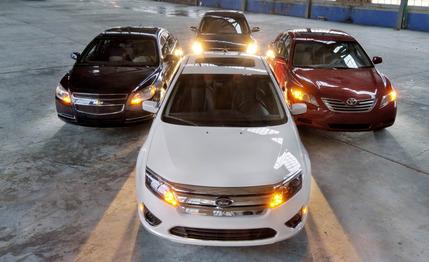 Comparison Tests
Comparison Tests
Like the price of sea bass on the restaurant menu, the cost of gas has become wildly unpredictable. As this comparison convoy of four family-size hybrids slipped past a station near our headquarters in Ann Arbor, Michigan, we noticed the posted price of regular had dropped to $1.78.
No worries, momma. Good thing nobody called on the ad to sell your Tahoe.
Hybrids get more compelling, of course, when gas zooms past four bucks a gallon. But that price will be just a sweet summer memory if Ahmadinejad busts a nuke over Tel Aviv. Closer to home, and more likely to happen short-term, Obama campaigned on a promise to cap and trade carbon, which is guaranteed to put gas prices on the up elevator. So we think hybrids are worth your consideration even if gas has gotten cheaper as you read this.
A little background: The mainstream media has recently been foaming all over itself about “plug-in hybrids,” a new category of someday cars that has replaced the hydrogen fuel-cell cars that were to happen someday in the foamings of a few years ago.
At least plug-in hybrids are technically more feasible than fuel cells. But whether they can soon be brought to market profitably and affordably is an open question.
The four hybrids here are readily available and run entirely on gasoline. They just run farther on each gallon than conventional cars. They do it without power cords. In fact, they are very much like normal cars except that the engines usually shut off when the cars stop moving.
That said, there are substantial differences among the hybrids within this group. The Chevrolet Malibu is what engineers call a “mild hybrid.” Added to its entirely conventional powertrain is a belt-driven motor-generator, this to capture a small share of the energy that would normally be wasted as heat in the brakes, then that energy is fed back into the drive system as needed for engine starting and acceleration. The reclaimed energy is stored in a relatively small nickel-metal hydride (Ni-MH) battery until needed. This type of hybrid cannot move the car without running the engine.
The potential fuel savings are small with a mild hybrid. If the added cost is similarly small, it could be a good buy. We’ll see.
The three other cars here are state-of-the-art fuel savers capable of moving at city-traffic speeds for a few blocks or more without running the engine, depending upon speed, slope, and, of course, the battery’s state of charge. These hybrids reach beyond regeneration (capturing “braking” energy) to give the fuel-burning engine a new assignment: It becomes an auxiliary power unit, called upon only when a computer decides that burning fuel is the most efficient way to propel the car.
Toyota has been the world leader in this style of hybrid, and the Camry operates very much like the now-famous Prius, albeit with upsized components appropriate to the dimensions and weight of this much larger sedan. For its Altima hybrid, Nissan licensed Toyota’s Hybrid Synergy Drive technology, so the Camry and Altima operate similarly, even though each relies on the automaker’s own engine.
While Toyota wears the hybrid halo, Ford mostly got yawns for the hybrid system it introduced in the 2005 Escape SUV, even though it was a full hybrid capable of Prius-like engine-off propulsion. Now, five model years later, the latest evolution of Ford’s hybrid thinking appears in the 2010 Fusion.
Never mind the high price of sea bass and the low price of gas, this calls for a comparison test. Which of these four carmakers builds the best family-hauling four-door hybrid?